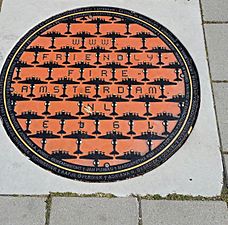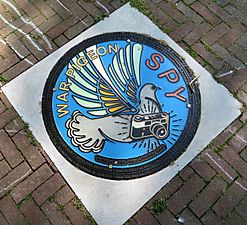Allied bombings of Amsterdam-Noord facts for kids
Quick facts for kids Allied bombings of Amsterdam-Noord |
|
|---|---|
| Part of World War II | |

Bewaarschool Buiksloterdijk after the bombardment
|
|
| Lua error in Module:Location_map at line 420: attempt to index field 'wikibase' (a nil value). | |
| Operational scope | Strategic air bombing |
| Location | Amsterdam-Noord |
| Commanded by | Allied Forces |
| Target | Fokker aircraft factory (Papaverweg 31-33) |
| Date | 17 July 1943, 25 July 1943, 28 July 1943 |
| Executed by | USAAF, RAF, FAFL |
| Outcome | 130 houses were destroyed, 206 houses were severely damaged, and 676 houses suffered glass and roof damage |
| Casualties | At least 206 killed At least 119 seriously injured |
The Allied bombings of Amsterdam-Noord happened in July 1943. This was during World War II, when the Netherlands was occupied by the Nazis. Three times, Allied planes tried to bomb the old Fokker Aircraft Factory in Amsterdam-Noord. This factory was important because the Nazis had taken it over. They forced workers there to build planes for their air force, the Luftwaffe.
But out of 326 bombs dropped, only 7 hit the factory. The rest landed in neighborhoods nearby. This caused the deaths of more than 206 people. These attacks were the most damaging and deadly bombings in Amsterdam during World War II. They were also the worst airstrike the city has ever faced. Because these attacks came from the Allies, the sadness and pain they caused have always been a sensitive topic for the people of Amsterdam-Noord.
Contents
Bombing Timeline
Within 11 days, the former Fokker Factory in Amsterdam-Noord was bombed three times by the Allied Forces. Here's what happened:
Saturday, July 17, 1943
![]() United States Army Air Forces (USAAF)
United States Army Air Forces (USAAF)
- 41 B-17 Flying Fortress bombers from the US Eighth Air Force took part.
- This bombing was a disaster. More than 200 high-explosive bombs fell on homes in Amsterdam-Noord.
- Not one bomb hit the factory.
- 185 people died, and 119 were seriously hurt. Many more were injured and later died.
Sunday, July 25, 1943
- 10 British B-25 Mitchell bombers attacked.
- They managed to hit the aircraft factory and mostly destroyed it.
- 4 more people were killed during this attack.
Wednesday, July 28, 1943
- 12 French bombers tried to bomb the factory again.
- This time, none of the 48 bombs hit the factory.
- Another 17 civilians lost their lives.
Factory Camouflage
The German occupiers had hidden the factory's roof and sides. They used nets, fake small houses, and trees. From above, this made the factory look like a quiet neighborhood. This might have made it harder for the bombers to hit their target.
However, witnesses said the Allied Forces knew about the Fokker site. For example, the USAAF Bomb Groups knew the factory was hard to find. Their crew briefing even called it "one of the finest pieces of camouflage ever photographed."
U.S. Bombing Details
The attack on July 17, 1943, by the USAAF was the worst bombing Amsterdam faced in World War II. The damage was huge.
In this first attempt to destroy the Fokker Factory, 41 heavy bombers (B-17 Flying Fortress) were used. These were from the 385th and 388th Bomb Groups of the US Eighth Air Force. It was their first combat mission. It seemed like an easy job because it was close to their base in England. They also expected little resistance from German planes. The crews even called such an "easy" attack a milk run. They were told clearly: "do not bomb unless the target is seen."
When the bombers flew over IJmuiden, the weather was bad. The lead plane's bombardier could not see the factory because of clouds. So, the group was told to stop the attack. But the new crew got confused. A plane behind the leader saw the target and dropped its bombs. Other planes followed.
The bombing failed badly. The USAAF crew saw "no bursts were seen in the immediate vicinity of the Fokker complex." Not one bomb hit the Fokker Factory. Over 200 high-explosive bombs landed 600 to 1200 meters away. They hit homes, a monastery, churches, and other factories. This attack killed 185 people. Hundreds were injured, and many later died from their wounds. 130 houses were destroyed. 206 houses were badly damaged, and 676 houses had broken windows and roof damage.
Anne Frank's Diary
Anne Frank wrote in her diary on July 19, 1943, about the American bombing. She heard it from her hiding place in Amsterdam's city center:
Amsterdam-Noord was severely bombed last Saturday. The devastation must be terrible; entire streets are in ruins. You hear of children lost in the smoldering ruins searching for their dead parents. I still get shivers just thinking about the dull, droning rumble in the distance.
—by Anne Frank, in The Diary of a Young Girl
USAAF Reaction
USAAF General Eaker told the Dutch government-in-exile on July 29, 1943: "I plead guilty and deeply apologize." He explained that the attack should have been stopped. He said the bombs were not aimed well enough. Eaker promised to do better. He would remind the USAAF of the "strong instructions" for bombing occupied areas. The pilots involved were also disciplined.
Marshal Portal of the British RAF wrote to Eaker: "I was sorry to hear that the Americans made rather a mess of Amsterdam . . . I hope that it may prevent a repetition of this trouble." The British wanted to avoid harming Dutch civilians. Earlier in the war, the Dutch government had criticized the British for too much violence. The Dutch government worried its citizens might lose trust in them and the Allies. They feared this would make people believe Nazi propaganda. Also, Allied plans for the liberation of Western Europe were starting. It was important for the Allies to keep the support of the people.
Eaker replied to Portal: "We have much bigger fish to fry." But he was also unhappy with his soldiers' actions. He did not want another failure like this. He said: "We cannot be party to the slaughter of our sympathizers and allies."
- Damaged bombardment sites in Amsterdam-Noord (July 1943)
British and French Bombings
After the USAAF's failed attempt, the British RAF tried again on July 25, 1943. 10 B-25 Mitchell bombers were used. This attack was more successful. Seven bombs hit the factory. But 71 other bombs fell along the Kamperfoelieweg. They damaged the St. Stephanus Church and many homes. 4 more people died in this second attack.
Because of the 7 successful bombs, Fokker had to spread its aircraft production. They moved it to 34 smaller places in and around Amsterdam. For the rest of the war, Fokker could not make as many planes as before.
Sadly, this news reached the other Allied forces too late. Three days later, on July 28, 1943, the French FAFL sent 12 more bombers. They tried to bomb the factory again. During this third bombing, 48 bombs missed the factory. They accidentally hit homes nearby again. This third French attack killed 17 more people.
Aftermath
Rebuilding and Repair
The damage from the three attacks was huge. The Hitler Youth came to help the people of Amsterdam-Noord. The Nazi propaganda machine used the accidental attacks on civilians to their advantage. The bombings caused many fires in the neighborhoods around the factory. Homes that used to belong to Jewish families, now empty due to the Holocaust, were given to victims who lost their homes.
The bombed streets of Amsterdam-Noord remained damaged even after the liberation of the Netherlands on May 5, 1945. For years, some survivors lived in their slightly damaged houses. They still smelled chemicals from the rubble in their streets. In the years after the war, the city finally rebuilt and repaired the houses in Amsterdam-Noord.
- Rebuilding and reparations (1946-1948)
Public Criticism
Most of the more than 206 people killed in these accidental attacks were civilians. 185 deaths were from the first American attack. People in the occupied Netherlands knew about the Norden aiming device. So, they criticized the USAAF bombers' accuracy. They said, "we are not convinced of the practical value of the much-praised excellence of the American aiming devices."
After the failed bombing, people in the Netherlands started to see RAF and USAAF attacks differently. The criticism grew. A prayer recorded by the MIVD from a source in the Netherlands showed this feeling:
Lord, save us from our protectors, and protect us from our saviors.
Heer, verlos ons van onze beschermers en bescherm ons tegen onze verlossers.
A Difficult Topic
Since these were Allied attacks, the event and its pain have always been a sensitive topic for Amsterdam-Noord residents. During the war (1940-1945), the Allies carried out about 600 bombings in the Netherlands. These killed around 10,000 citizens. Accidental civilian attacks by the Allies, like the Fokker Factory bombings, are known in Dutch as "mistaken bombardments" (vergissingsbombardementen).
However, in the Netherlands, these events were often called "unspoken bombings" (verzwegen bombardementen) for a long time. The fear and pain from the bombings were hidden by survivors. This was because their attackers were seen as "the good guys" of the war, not the enemy. Especially at home, these sad events were never talked about again.
When you brought up the subject, they would say: “Stop it, it was a mistake by the Allies.” It was a concealed and unspoken subject. You weren’t informed [by adults] about what actually happened during the event. We [the children] talked about it among ourselves, but we didn't really know anything.
—A childhood memory of the situation at home from one of the survivors. At 8-years-old, he was one of the 700 children attending a special children mass in the St. Rita church, which was heavily bombed during the first raid.
Acknowledgment
The pain from this terrible event is still felt in Amsterdam-Noord. Talking about their experiences during the bombings affected victims, even many years later. It took generations for the public to understand the impact and pain this event caused. Today, the Dutch public values teaching younger generations about those who fought for freedom in World War II. This has led to interest in the stories of the bombing survivors. Their stories can now finally be told and recorded for the future.
Memorials
Throughout Amsterdam-Noord, war monuments and memorials remember the losses and damage. They show the impact on the people of Amsterdam-Noord:
- In the late 1940s, Fokker placed the first Fokkermonument at their factory headquarters. It honored employees killed by bombings or by Nazis. Their names are on a plaquette. On July 3, 1999, this monument moved to the Amsterdam-Noord municipality office.
- In the rebuilt houses at Fazantenweg 14-16 and Kievitstraat 21, there are gable stones. They remember the rebuilding of homes (1946-1948) after the July 17, 1943, bombing.
- On September 22, 1951, the former Mayor of Amsterdam, Arnold Jan d'Ailly, unveiled the Phoenix statue. It was designed by Hendrik J.J. Dannenburg. It stands at the heavily bombed Mosveld-square. Like a phoenix, Amsterdam-Noord would rise from the ashes. The concrete column reads "1940-1945". It remembers all citizens of Amsterdam-Noord who died during the occupation, especially bombing victims. The people of Amsterdam-Noord paid for the statue themselves. During the building of the IJtunnel in 1968, the statue was stored. From 2014-2016, the Phoenix moved permanently to a park on Kamperfoelieweg / Azaleastraat.
- On July 17, 2003, the second Fokkermonument was unveiled at De Nieuwe Noorder-cemetery. 93 of the 206 bodies were buried here. The cemetery holds one of Amsterdam's official yearly events at the Fokkermonument on Remembrance of the Dead (May 4).
- In 2018, the city of Amsterdam placed 11 memorial manholes. This artwork series is called Friendly Fire. The art by Hester Oerlemans is spread across the bombing zone. It tells the bombing story with pictures.
- Memorials and monuments
See Also
- Allied bombing of Rotterdam in World War II
- Bombing of the Bezuidenhout
- Bombing of Nijmegen


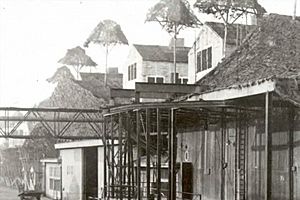
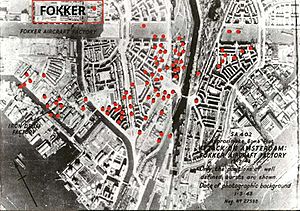
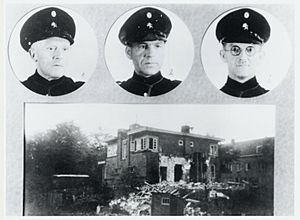
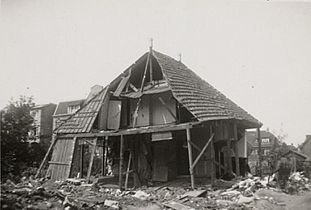
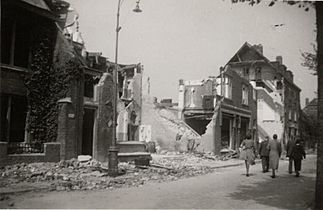
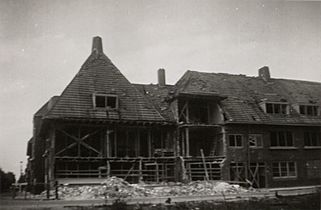
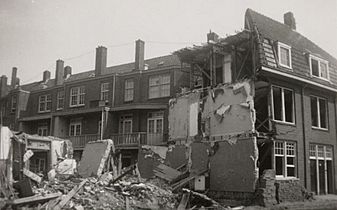
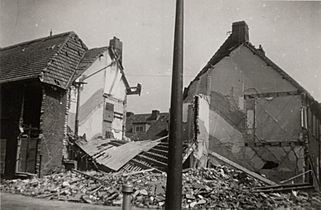
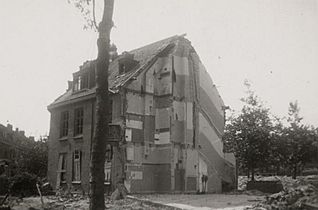
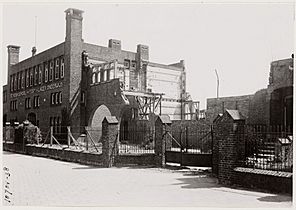
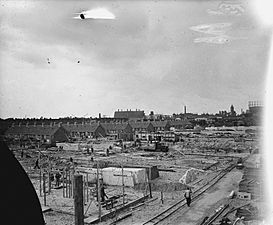
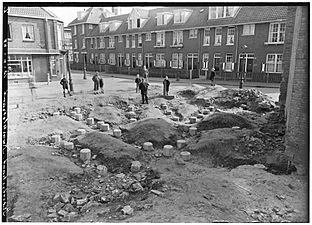
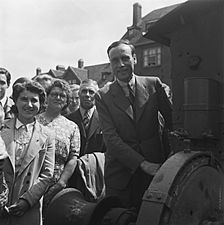
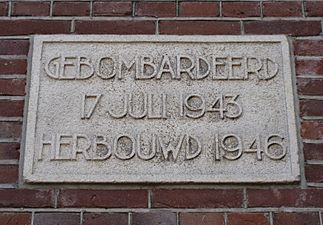
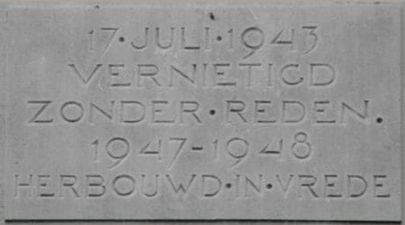
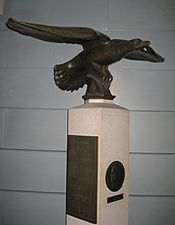
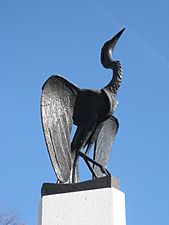
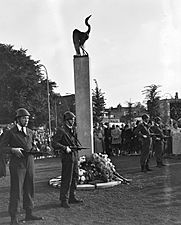
![Fokker-monument (at De Nieuwe Noorder cemetery)[11]](/images/thumb/0/00/Fokkermonument.JPG/169px-Fokkermonument.JPG)
